Check Out This Guide:
CUSTOMER CONNECTIONS ON TAP: A GUIDE TO USING DATA FOR MARKETING
Technology
OCT 25, 2021
Share
In 2020, customers in the U.S. spent a total of $769 billion on ordering food from restaurants, with 63 percent of that number ($486 billion) on take-out food. That’s a ton.
With this now established consumer expectation of being able to order food online for pick up or delivery, it’s no surprise that the industry will be worth $200 billion by 2025. Online ordering has grown 300 percent faster than dine-in traffic since 2014 — so this is a trend not expected to dissipate anytime soon.
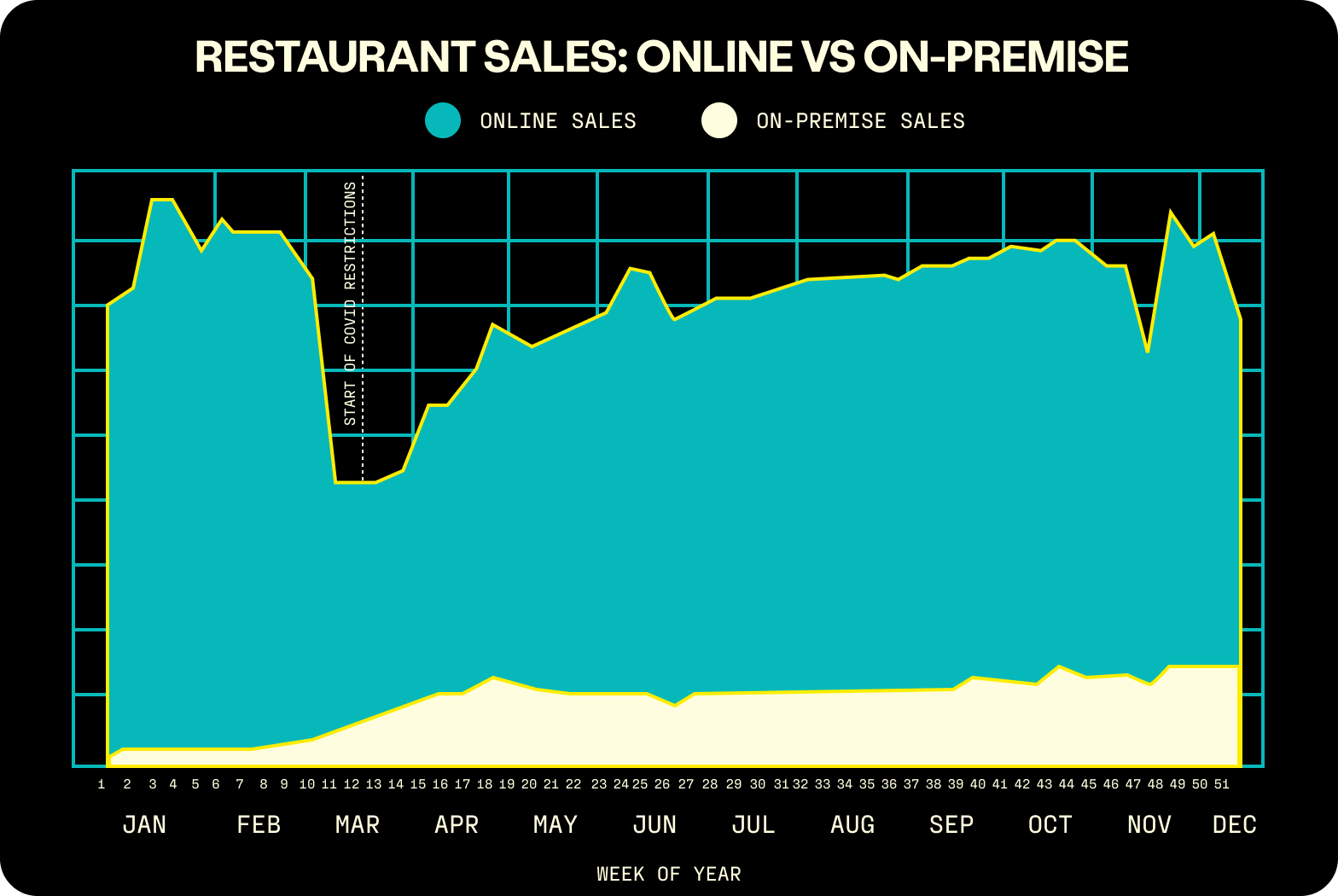
Average total sales per week made on-premises and online in 2020. Source: Paytronix’s Order & Delivery Report: 2021
How are restaurants supposed to cope with the strain of a 124 percent increase in online orders since March 2020, all while managing day-to-day operations in the aftermath of the pandemic?
The answer? Kitchen management software.
It is estimated that over one million restaurants currently exist in the U.S., many of which have adopted kitchen management tools to streamline all operation processes. If a customer cannot experience a smooth process from ordering to eating, they will likely choose to order food elsewhere. Customers will return to restaurants where they experience excellent service and consistency. Kitchen management software is key to keeping a competitive edge as well as ensuring customer satisfaction.
The kitchen can quickly turn into a place of chaos, especially during breakfast, lunch, happy hour, or dinner rushes. Physical order tickets can easily get lost, and it is not uncommon for the kitchen to run out of key ingredients for menu items. Orders can come flying in from multiple streams all at once. This can be stressful for back-of-house (BOH) staff, and strain communication with the front-of-house (FOH) staff.
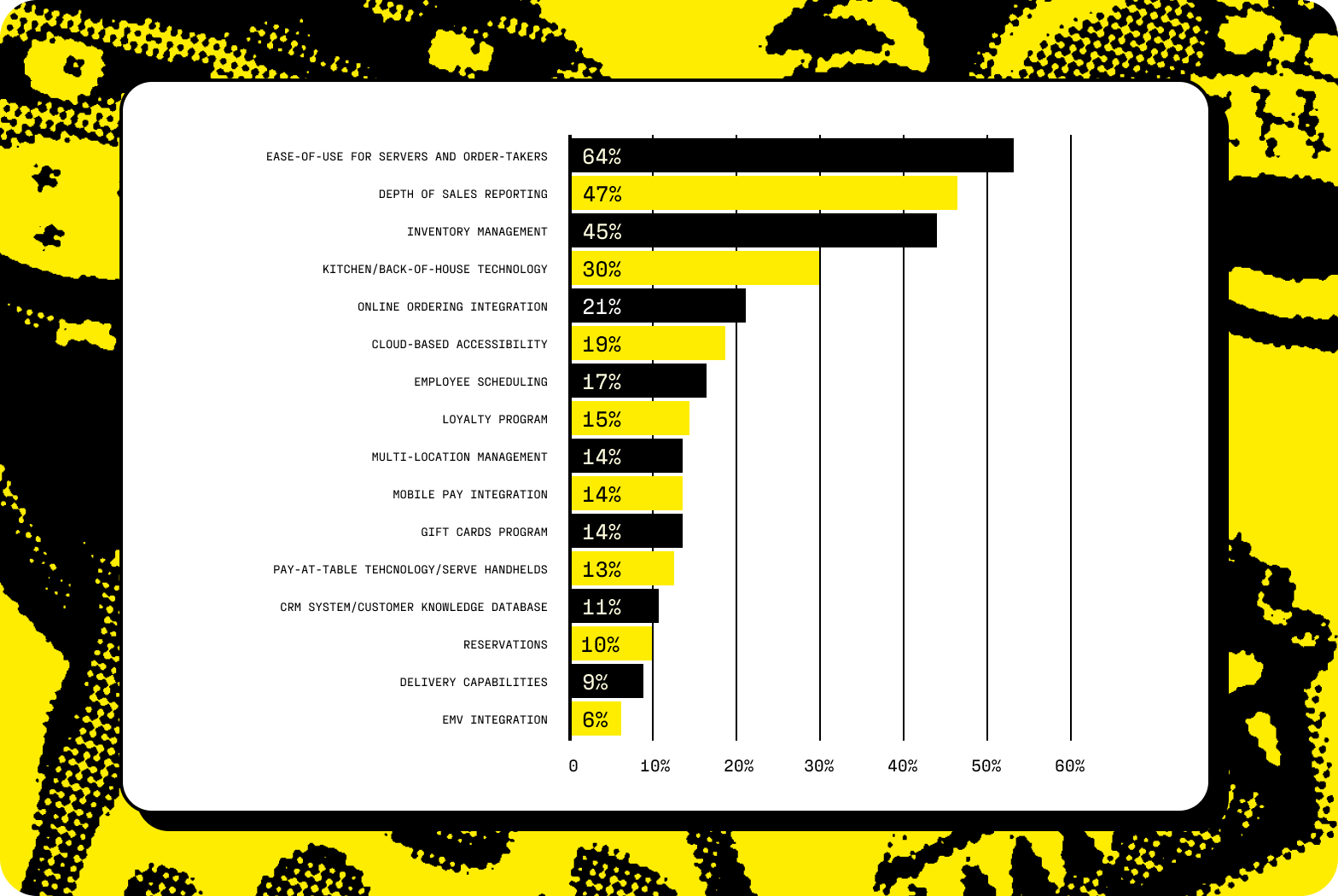
Restaurant businesses were asked to name the top three most important features in a POS upgrade. Source: Toast’s 2017 Restaurant Technology Report
In Toast’s 2017 Restaurant Technology Report, it was reported that 95 percent of restaurant owners say tech improves their overall efficiency. Management software is crucial for connecting and automating back-of-house, front-of-house, and back-office operations. An efficient system can save restaurants money, assist in hitting target margins, and reduce food waste. Simply put, the right kitchen management software can increase a restaurant’s customers, orders, and profit.
Check Out This Guide:
CUSTOMER CONNECTIONS ON TAP: A GUIDE TO USING DATA FOR MARKETING
For ghost or cloud kitchens, kitchen management software is key for the optimization of food preparation and delivery time. The right software can drive the consistency and quality of online food orders, resulting in customer satisfaction and loyalty. Cloud kitchens may use software designed for this specific business model, where customer-facing components are eliminated for the sake of order and delivery functionality.
Also referred to as food service or restaurant management software, these programs allow restaurant owners and managers to integrate and automate anything used to operate their restaurants. Old systems are often comprised of multiple software programs hacked together that can sometimes be archaic and inefficient.
Most restaurants have some form of a point of sale system (POS). There can be overlaps with restaurant management systems and POS systems, but typically, restaurant management systems are more comprehensive. Many management systems come equipped with POS systems, but some existing POS systems can also be integrated into management software.
The key features included in kitchen management software are the ability to track food orders, inventory management, order preparation information, analytics for performance analysis, menu planning capabilities, and employee management.
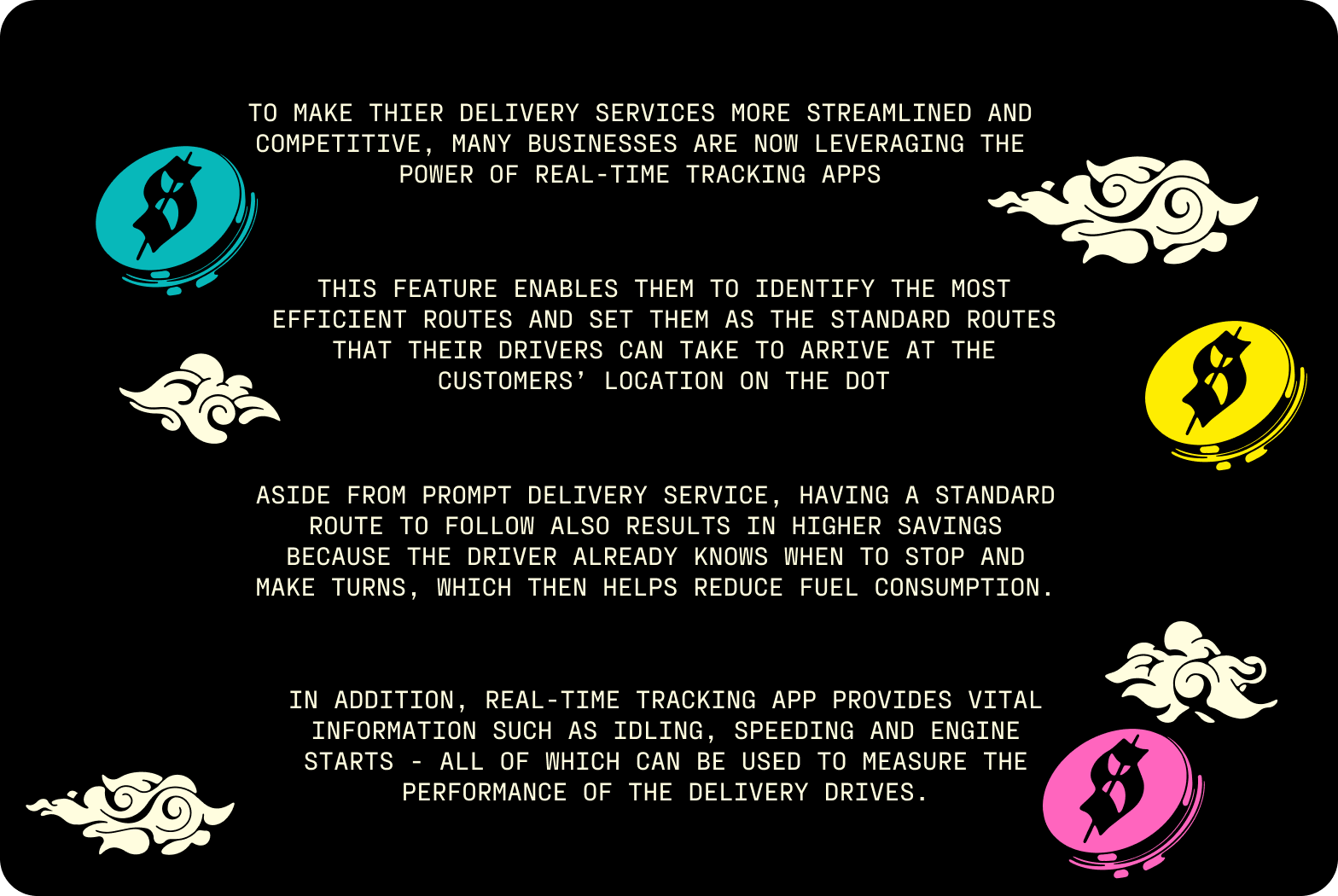
Top Benefits of Real-Time Tracking for Food Delivery Service. Source: Modern Restaurant Management
Missing items and delayed orders are blunders that can be left in the past. A kitchen management program allows for a food order to be tracked from the time ordered to when it is successfully delivered to the customer.
With the right software, omnichannel orders streaming in from third-party delivery sites, phone calls, mobile apps, and website orders are consolidated into a single dashboard for the kitchen staff’s convenience (and sanity!).
For delivered meals, the average customer reported that 40 minutes is the longest that they would wait for their order to reach the doorstep.
After an online order is placed, customers expect to be able to track it in real-time. If there are delays from the time of order to delivery, the software should be able to record this data to help determine how and why this delay arose, and communicate the issue to the customer.
When consumers decide they don’t feel like spending the time cooking a meal at home, they turn to ordering food online. In opting out of a home-cooked meal, they expect ease of ordering, quick processing time, and the ability to track their order.
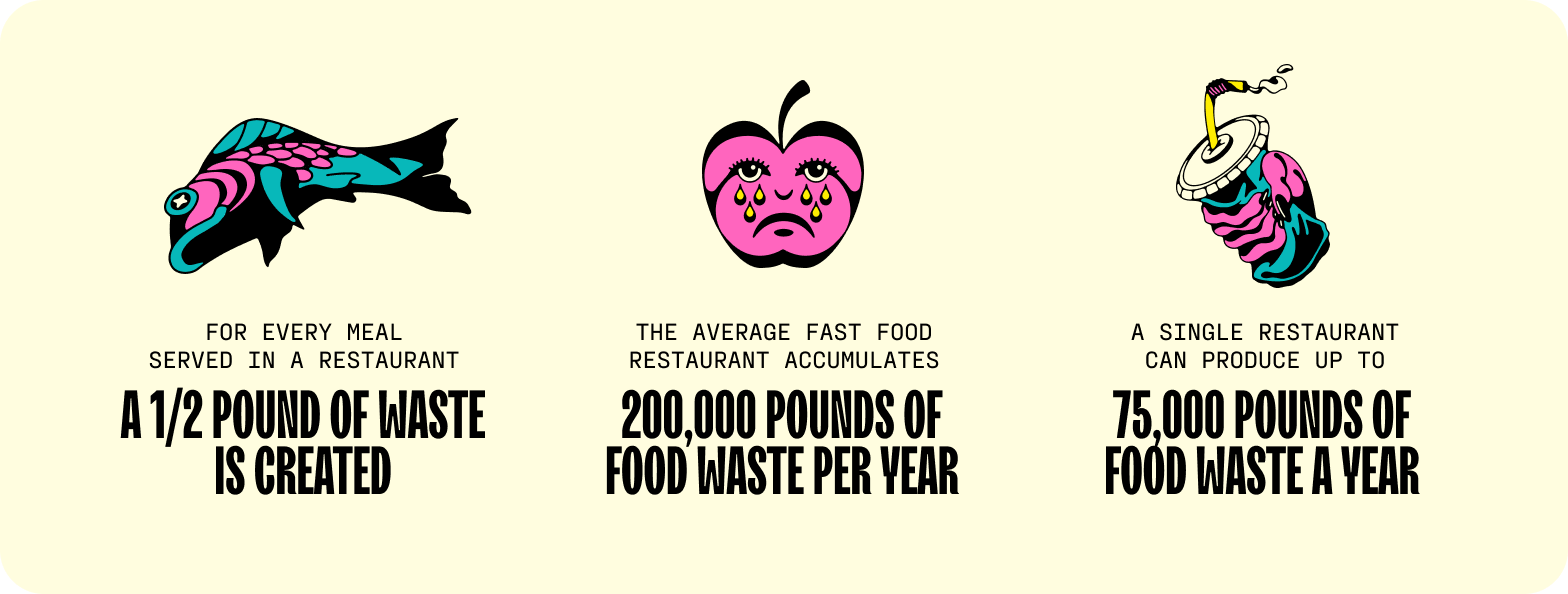
FoodPrint estimates that US restaurants waste 22 to 33 billion pounds of food every year. Photo Source: TheDigestOnline.com
According to Toast, 56 percent of restaurateurs cite that food is their biggest cost. Restaurants can spend anywhere between 20-40 percent of their revenue on food and beverage; the average has been found to be between 28 to 35 percent. The higher the food costs, the tighter the profit margins. With the added pressure of operating a restaurant during the COVID-19 pandemic, profit margins have been even tighter for restaurants.
Inventory loss is something that occurs on a daily basis in most restaurants. It may not seem like a huge loss to toss out a few pounds of lettuce or dump a sour carton of milk, but restaurant owners know this adds up over time.
Since food is typically the highest cost in a restaurant, throwing out food is throwing out money.
Inventory control is a critical part of running a successful and profitable operation. Using kitchen management software can reduce a restaurant’s food costs as well as food waste.
Spending time organizing incoming orders can significantly slow down the kitchen. This not only leads to stressed BOH staff, but disgruntled customers who may not return after their order was delayed. What if this entire process could be automated? Rather than staff trying to organize the priority of orders rapidly coming in, high-tech software like a management program can do this for you.
The kitchen staff will be able to view incoming orders from multiple channels on a single dashboard. This will allow for the workflow to be significantly improved, and reduce the risk of an order getting lost in the mix. We’ve all been the disappointed and “hangry” customers wondering what took so long to receive their meal, and what happened to the side of fries.
Kitchen management software collects and aggregates real-time data. Restaurateurs can use this collected data to analyze trends over time. With this information readily available, inventory can be ordered, and menus planned accordingly. Equipped with this information, owners and managers can drive sales and keep customers happy.
Inventory, recipes, and menu planning are all interconnected.
Using collected data from the past week, month, or even year will show what menu items performed well, and which ones were a flop. The data can inform what stays on the menu, what gets eliminated, and what new dishes will be added.
Chefs can enter recipes used by the restaurant into the management software. With the recipe management feature, the system can show if the current inventory supports the selected recipe, and this can determine what will be on the menu for the day or week. Some systems will provide allergen and nutrition information on entered recipes, as well as recipe costs.
Restaurants should easily be able to plan menu items based on inventory available, but this is not always the case. Human error is always feasible when checking what is stocked in inventory, and what is running low. Guesswork can be taken out of the equation by having the software do it for you. When certain ingredients and menu items run out, the online menu can also be updated automatically.
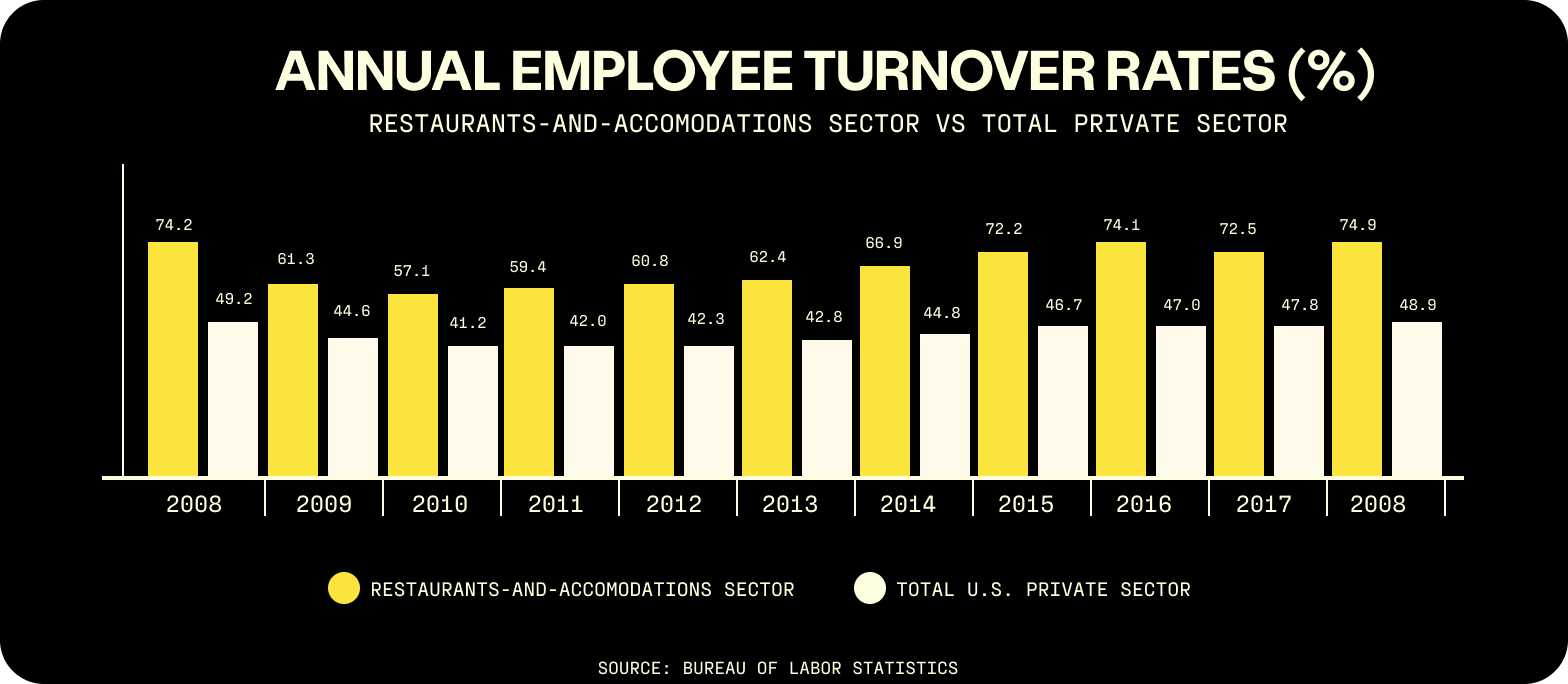
High turnover rates in the restaurant industry can increase labor costs.
Within a restaurant business, employees are spread out amongst the BOH, FOH, and the back office. Overseeing employees separated into multiple departments, working on various jobs on different days and times can be a challenge, but a kitchen management system can help.
Labor is cited as one of the highest costs of operating a restaurant, following food costs. The restaurant industry is known for having a high turnover rate, and in 2018, the turnover rate was at a high of 74.9 percent. Training new employees takes time and it is a hefty cost that can add up.
Management software can gather data on the total cost of labor, and assist a restaurant with identifying if it is spending too much or too little on labor costs. It can also track training costs and employee productivity, manage shift scheduling, and streamline the payroll process.
With so many different software programs to choose from, it’s important to consider several components. Some features to look for are the ability to customize, ease of integration, fees, costs, and the level of customer service offered.
No two restaurants are the same, and therefore, the system you choose should be able to be customized to your restaurant’s exact needs. It is likely that your restaurant has programs and systems in place already, so whatever software you choose should give you the ability to integrate into your current systems.
A beloved, small hole-in-the-wall restaurant serving crepes will have different needs than a full-service fine dining restaurant that requires reservations weeks in advance. A quick-service restaurant (QSR) with multiple locations will have needs that look completely different from the other two business models. All of these restaurants and various business models would certainly benefit from using kitchen management software, but how the software is used will look different for each.
Running a restaurant is hard enough, and integrating a new management system should make everything simplified and automated. If it is an arduous process to integrate a new system, then it might make more sense to select another option. The selected system should be intuitive to restaurant managers and staff, or easy to train how to use it.
Many companies offer management software at different pricing tiers. Each tier going up adds additional features and functionality. The lowest tier might be great for a small, single-location cafe, while the highest tier is best for a multi-site full-service restaurant concept. Some companies even offer introductory promo deals like $0 upfront or $0 per month for a limited time. It is important to consider the initial upfront costs, as well as how much your restaurant will be spending per month for the system. For certain systems, a company may require you to purchase its hardware.
Referring back to “ease of integration”- it is best if a company’s customer service is able to assist with the integration of its software. It is inevitable that questions will arise throughout the installation process. A kitchen management system is supposed to streamline your restaurants’ operations, and waiting on the phone for hours with customer service only slows down the process.
Post-installation, kitchen software companies should still provide support free of cost. Ideally, the company’s customer support should offer seven-day-a-week support through email, live chat, and phone. Support offered 24 hours is the best-case scenario, especially since most restaurants operate past the typical customer service hours of 9 am-5 pm.
Kitchen management systems will save restaurant owners and managers time, but searching for the perfect system can certainly be time-consuming in itself. Many companies offer comprehensive systems, but not all will be the ideal fit for every restaurant. Here is a round-up of the seven best management systems for restaurants.
XtraCHEF is used by thousands of restaurants and foodservice operations, including Jose Andres’ ThinkFood Group, La Colombe Coffee, Papa John’s Pizza, CHOPT, and Union Square Hospitality Group. The platform’s financial and operational tools allow food industry operators to maximize margins. Some of the management system features include AP automation, food cost management, real-time reports, recipe management, and inventory management.
Restaurant 365’s cloud-based platform is used by over 12,000 restaurants, including Buffalo Wild Wings, Blaze Pizza, Sbarro, and Freddy's Frozen Custard & Steakburgers. This system offers accounting, inventory, payroll, and reporting software that can be integrated with a restaurant’s POS system and banking partners. Operations and finance tools are displayed on the same dashboard, and the company also offers a mobile app as part of the system. It is a viable option for multi-unit and franchised restaurants.
The main highlights of Foodager include efficient ordering, automated accounting, and menu planning to maximize profits. With this system, restaurants can go fully paperless throughout the ordering and receiving process. This management system works for single and multi-unit establishments, including QSRs, full-service restaurants, bars, nightclubs, and hotels. With its ability to track every cost, Foodager allows operators to save money and increase profits.
Apicbase provides its platform to full-service restaurants, hotels, restaurant chains, and quick service establishments. This software allows its users to keep track of and control food costs, calculate margins, and manage all back-of-house operations. The company offers nine “module” components, including sale analytics, inventory, and menu planning, that can be used and added as the restaurant needs.
POSist serves QSRs, fine dining restaurants, and everything in between, including cloud kitchens, bakeries, microbreweries, and food courts. This cloud-based restaurant platform as launched in 2012, and is used by over 10,000 restaurants throughout 35 countries. POSist can work with restaurants and establishments of any size, and offers intuitive POS technology,
UrbanPiper offers tools to optimize a restaurant’s digital capacity and online presence. The company’s suite of products include customizable websites and apps, CMS + CRM dashboard, and campaigning tools. The cloud-based system allows for the latest system updates and bug fixes free of charge. 16,000 restaurants worldwide use UrbanPiper, including McDonald’s, Taco Bell, Pizza Hut, and Dunkin’ Donuts.
Jamix’s kitchen management system can be used by all types of foodservice establishments, including restaurants and chains, cafeterias. The cloud-based “kitchen management system offers menu planning, nutrition analysis, inventory management, recipe management, and procurement. It aims to create more sustainable kitchens, and can be used by any size of foodservice operation.
Although many restaurants already use a point of sale system, this alone might not cut it in a world where customers increasingly turn to online ordering. Using a kitchen management system can help restaurants streamline and automate operations, and in turn, provide consistency and convenience for the customers. Customers, orders, and profit have the potential to be increased with the right tech-forward system.
ENTER YOUR EMAIL TO STAY IN THE KNOW!